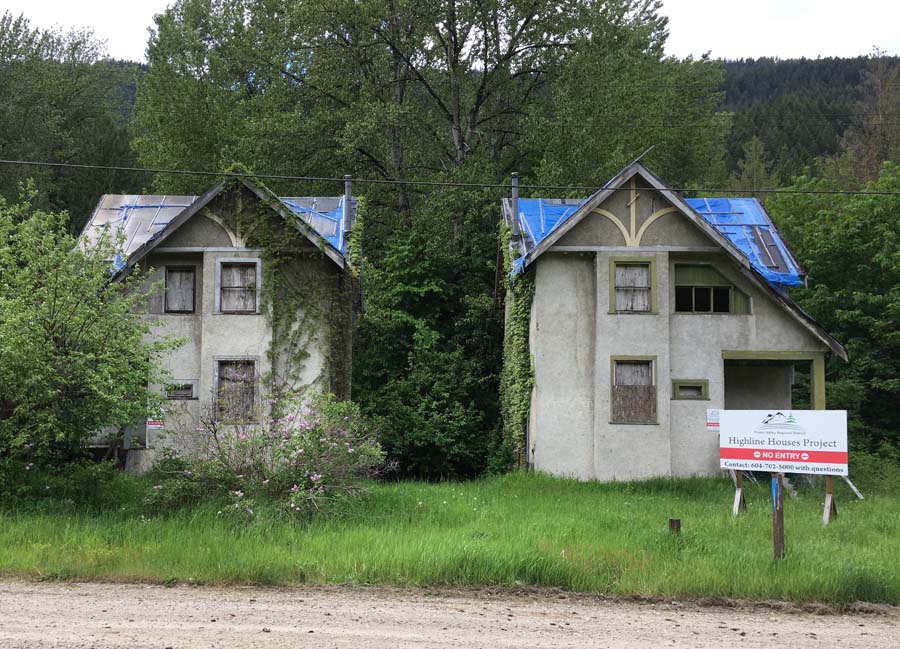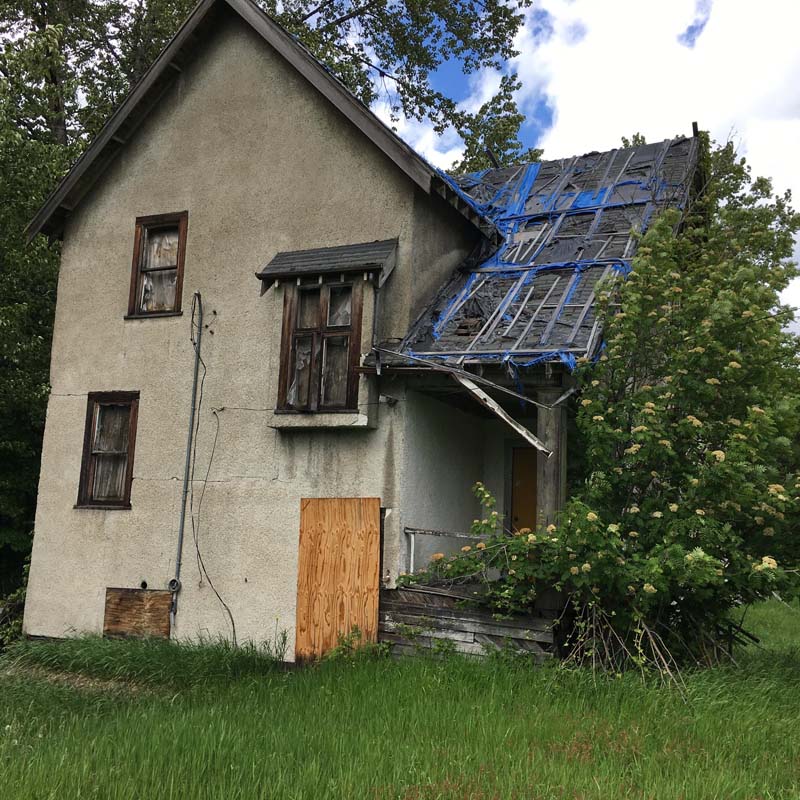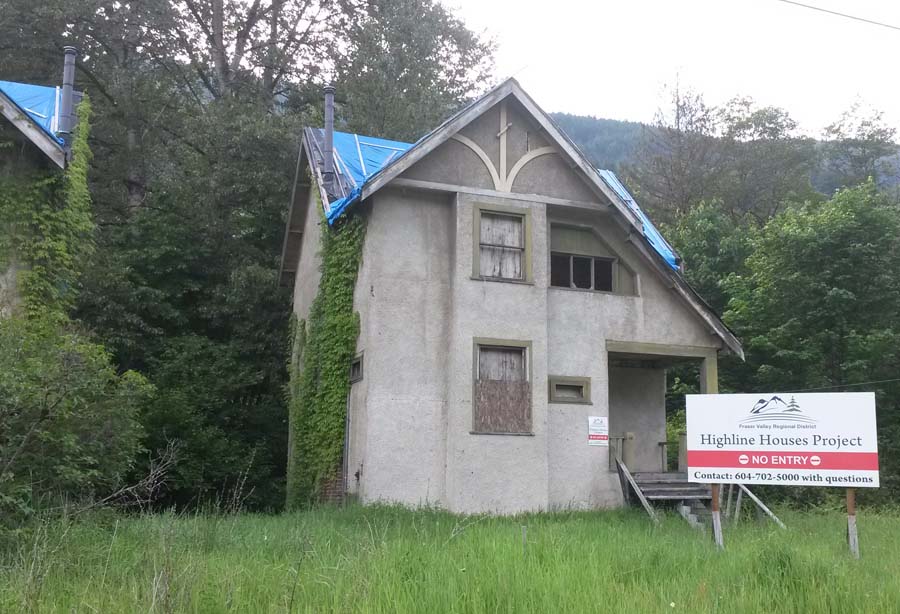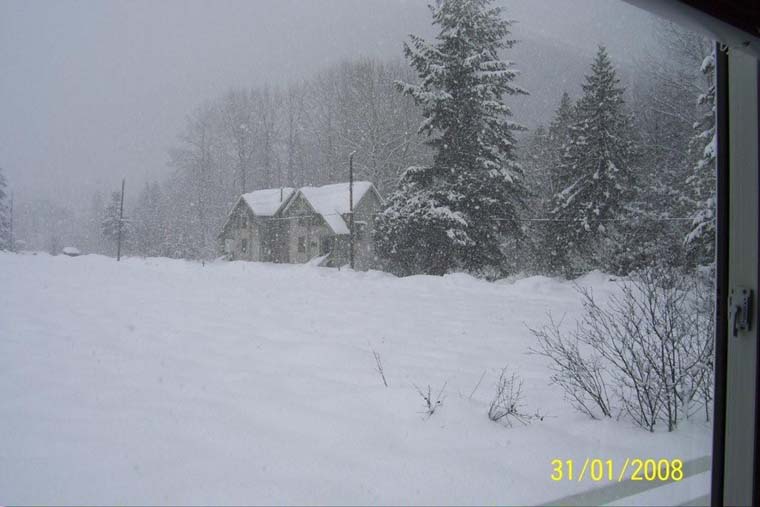This page last updated June 16, 2022
© Michael Kluckner
|
Due to the amount of material, there are 5 North Bend pages: this one, the Harry Lee house, the North Bend store/CPR Hotel, the Mountain Hotel and People photographs & correspondence |

A Spring, 2002, watercolour of the "highline houses" in North Bend. These are the two survivors – numbers 7 and 8 of the original row
The same two houses in 1999. They have been abandoned for years, and are apparently owned by the Regional District.
|
|
|
| The 8 high-line houses, all built in 1913 according to the CPR's Property Value Sheet (CPR Archives, Montreal), featured three styles. Four of them had a sweeping asymmetrical gable (the two surviving ones painted in the watercolours above are that type). Two of them had a projecting gable above a stoop, illustrated at left, while another two had a bay window set into the lower storey of its secondary gable. Photos from Lillooet-Fraser Heritage Resource Study, 1980, which only survives as a xerox copy. |
|
|
I decided in October [2002] that if I didn't actually break in to one of the boarded-up houses I'd never see the inside, as the next time I went to North Bend they'd be torched or demolished. Fortunately for my reputation as a law-abiding citizen, I found that the plywood panel over the back door of one of the houses was already partially ripped out. The house had been squatted in, as there was semi-pornographic, political graffiti scrawled on the walls in one of the upstairs bedrooms. The unheated houses are obviously deteriorating very quickly, with plaster coming down from the inside walls, but the floors are true and solid, so far, and there isn't any evidence of leaks through the roofs. As can be seen from the floor plans, the Highline Houses are sophisticated, efficient designs, with bathrooms on both floors, a boot room as an adaptation to the extreme winter climate, and good closet space--different from the houses of a decade earlier, where most storage was in pieces of furniture like armoires. I find it particularly interesting that one of the sidewalls is almost completely windowless (it only has two very small windows on the sides of the fireplace), making it possible with little modification to build the houses as duplexes. |
|
Update 2022: stopped by and, sad to
say, the houses are much the same, only worse, than in 2019.
  ****  Update, 2019: the houses still boarded up, the offer still open... Reproduced by permission of the Hope Standard Note from C.B. Peters, 2002: The houses that you painted were known as the 'highline'. There were around 10 houses [apparently only 8--ed.] along that road in 1948, the year my family moved into the 5th one down. They were built by the Canadian Pacific Railway in 1900, 1906 and 1913. I imagine that the first houses built were at the beginning of the street and the final two, that you painted, would have been the last built. My Dad was the night foreman at the C.P.R. shops. He worked a 12 hour shift 6 days a week with Thursday off, if there was no emergency. If there was, he worked the 7th day at no extra pay because he was an official and a salaried employee. Hard to believe in this day and age. The cafe that you mention was originally the main store in town, owned by Mr. and Mrs.Elmer Carlson. They moved the store to that location from across the tracks sometime in the 1930s. We lived in North Bend until 1951 when the federal government introduced the 40 hour week that summer and the C.P.R. brought in the diesel engines. North Bend was a vibrant community and we were always busy, what with Dave Weinmaster's North Bend brass band and the never ending 'plays' that we were constantly putting on at the town hall. The town hall burned down in the 60s I believe. We had one public phone in town located at the 'Lunch counter' so if one had to make a long distance call everyone in town knew about it as there was no booth and no other phone in town as they hadn't yet brought phone service into the town at that time other than that one line. Note from Tammy Tait, 2006: My family lived in number 7 house in 1986 till 1989, we were unfortunately the last family in it I believe. My dad was deputy roadmaster, #8 house was for the visiting officials back then. I knew so many of the faces in the pictures you had, what a hoot. I met someone years later who had been a railway brat too and he had grown up in #7 house back in the 50's. As soon as I saw the artwork I was transported back to my room in that old house, the sounds of those wooden stairs the lovely sitting area. Hmmm were there still the fruit trees in the back? we used to watch the bears eat the plums in the summer and watch the occasional cow break out from our kitchen window. The articles were interesting because most of those people are the grandparents even great grandparents of people we knew. I have looked at all your work and I have experienced a lot of these places on my railway journey. My dad was the last roadmaster on the kettlevalley line, and as I looked at the island part of Vanishing BC I had a good chuckle, the old scale shack in Nanaimo was actually my office when the CPR still owned the E&N! Note from Parm Basra, 2005: I was born in Lytton then raised in North Bend and my family has the somewhat dubious honour of being the last people to live in not just one, but two of the Highline houses. My father came to Canada in 1969 from India with the dream of a better life for his children. I can still remember the often pointed-out spot on the Trans-Canada in the Fraser Canyon where my dad, knowing English from having been a teacher in India but still thickly accented from having been in the country for five days, walked up to the CPR bridge crew that was set up on a siding and asked for work. It was the beginning of a 20 year career with the railroad which continues on to this day with my eldest brother. It was not too long after that he found himself spending his days off at my uncle's house in North Bend (one of the foreman's houses pictured [below], a scar on the back of my head the legacy of stairs too steep). After airfare had been saved my mother and two brothers (I was yet a twinkle in the eye) joined my father. At some point the crowding must have become unbearable (no one ever seems willing to give me an honest answer) so our family moved across the street into the infamous Pig's Ear. It was there that I spent the first months of my life as my father bided time until one of the sought-after Highline houses became available (I believe that rent on the houses in 1980 was $29 per month). We lived in #3 until about 1979 or 1980 and then moved to #2 (I think the reasoning was it had a better furnace and insulation) where we stayed until the late 80's. I know this will break you heart but I remember my excitement on the day I came home from elementary school to discover CP plans for #3 once we had moved out: Demolish it with a few well placed splashes of gasoline and a match. Note from Brian Avery, 2005: I moved to North Bend in 1969 and lived there about five years. My home was number two on the Hiline. Having grown up in Saskatchewan and Manitoba, living in the Fraser Canyon was quite an experience. The first winter was one of the worst in many years. I worked for CP Telecommunications in the "repeater hut," a small brick and concrete building built to withstand bomb damage (it was built either during or after World War II). During the first winter I worked many hours of overtime as the open wire line was broken many times by slides. One time during that winter the CPR passenger train, the Canadian, was stuck in town for two or three days because of slides on the railway. What an experience for a prairie boy! it. Note from Wendy Sahaydak, 2004: My Dad worked for the CPR in North Bend from the late 40's to early 60's. My parents lived in the house on the right in your painting [of the "Highline" houses] in 1949, when I was born. My Mom was the only RN in North Bend for many years, and was called out when babies were being born, people were injured and people died. [She recalled a woman who brought her baby] to Mom, who told her that from his symptoms, he had a bowel condition that could be fatal and urged her to get to the doctor asap. We had to take the train for 5 hours to get to the doctor in Vancouver. Apparently the baby was treated and recovered . . . . I lived in North Bend for the first 12 years of my life and have wonderful memories of growing up there. My best friend lived on the high line and I have many people I still keep in touch with from our North Bend days. My Dad helped Dave Weinmaster with the band, and I can recall we all went over to Boston Bar to see Queen Elizabeth and Prince Philip come through town on the CNR, and Dave's band was on the platform playing. After the town hall burned down in the early 60's, my Dad was one of the men who rebuilt it. We used to go to the movie every
Thursday night, the children went to the first show for ten
cents, and the parents went to the second show. When the kids
got home, we'd all get on the phone, as we had party lines and
had three or four people on each line--so we could have about
six kids talking on the phone at once, that was our
entertainment – there was no TV in those days. Last June my
Mom, brother and myself scattered Dad's ashes on the
Nahatalach River and then returned to the house on the right
of your painting so Mom could tell us stories of their time
there. We also went to Spuzzum as my Dad was born in a CPR
house in Spuzzum, delivered by Ma Richmond, who is the
grandmother of Claude Richmond, a well-known politician from
Kamloops. |

| Note & photo from Lorna Regehr, 2008: My husband Al and I bought a house just north of the Highline Houses last August and these two houses are our 'much loved ghost neighbours'. I was on the 'net and picked up your page and thoroughly enjoyed reading about early days of our new hometown!! According to our city friends (who haven't been here yet) we are absolutely doomed to boredom living in a place like that – if only they knew how beautiful it is here. There are so many places to visit in the Canyon area and a lot of history to learn about. |
|
|
|
The authors of the Lillooet-Fraser Heritage Study identified the two foremen's houses above as interesting examples of "boxcar architecture." Both are demolished, or at least altered substantially.
